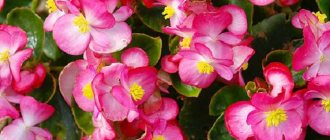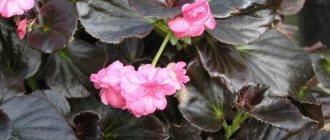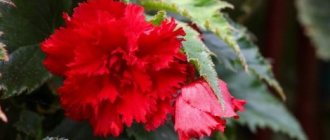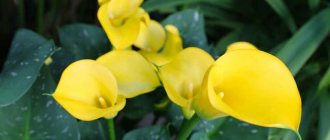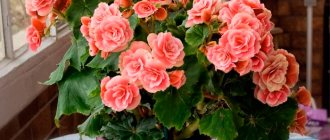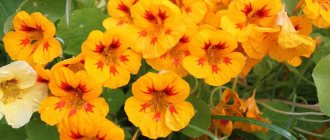Tuberous begonia, the planting of which is the topic of this article, is loved by flower growers for its very spectacular flowering. An ornamental plant for growing at home all year round, and in the garden only in summer, it does not tolerate low temperatures and does not require any complicated care.
But compliance with the planting and maintenance rules specific to tuberous begonias is mandatory. If you ignore the main points, you can hardly wait for at least healthy sprouts, not to mention buds.
Plant characteristics
Tuberous begonia (Begonia tuberhybrida) is an unpretentious perennial plant. It looks great anywhere, is very versatile and extremely popular. Begonias were first described in history in 1690 by the French botanist Charles Plumiere. The name comes from another French plant expert, Michel Begon, and was used as a tribute. However, the delicate colorful flowers were known much earlier - according to historical sources, they were grown in China as early as the 14th century.
Numerous varieties make the begonia flower widespread and very popular among gardeners. The plant has been known in Europe for many years. Garden begonia flowers grow well in our climatic conditions; many varieties are created by crossing numerous species from Africa and the Andes.
Begonia is a small plant, the length of its shoots rarely exceeds 30 cm. The flower tends to branch quickly, which makes it even more attractive. It looks like a small bush decorated with beautiful flowers. The leaves are noteworthy - short, heart-shaped, fleshy and shiny, planted on rather long petioles.
Outdoor begonia blooms from June until the first frost, so it becomes the best decoration for the summer and autumn garden. Winter or ever-blooming begonia (Begonia x semperflorens-cultorum) is also known. Tuberous begonia owes its name to the fact that it forms underground tubers with the help of which it reproduces. Plants planted in the garden look very impressive. These flowers are also suitable for growing in pots, outdoor containers, and on balconies.
Beneficial features
Tuberous begonia growing indoors helps purify the air, destroy pathogenic microbes and suppress allergic reactions. Tubers of the flower are used in alternative medicine, as they relieve spasms and relieve pain.
In Feng Shui, begonia is known as a plant that effectively restores weakened energy. She has the ability to cleanse the home of negative energy and fill it with positive energy. Therefore, she is recommended to definitely decorate her home if quarrels and scandals often occur in it.
TUBER BEGONIA. Basic RULES for planting and care! What pot should I plant begonia in? Correct watering
Varieties and varieties of begonias with photos
It is difficult to describe in words what begonia flowers look like. Plant varieties represent a huge collection of different colors and shapes.
There are 2 popular garden species that can be grown outdoors:
- Tuberous (Begonia x tuberhybrida) with large multi-colored flowers.
- Semperflorens – ever-blooming or ever-blooming (Begonia semperflorens). Grows up to 50 cm in height, blooms from spring to autumn.
The following species are usually grown at home:
- royal (Begonia rex) - with beautifully colored leaves;
- winter (Begonia x hiemalis) - with extremely noble pink inflorescences.
Some species are annuals and require annual planting, while others, such as tuberous begonias, can overwinter.
There are tuberous varieties with semi-double, double and single flowers. Also popular is cascading ampelous begonia with much smaller flowers. Royal begonia does not produce many flowers; its leaves give it a decorative appearance.
Begonia varieties are difficult to count, their number is huge, as well as the number of variations and varieties. In the house and garden, standard tuberous begonia is most often grown, which is divided into 3 main groups. The criterion for division is the type and size of flowers.
- Large-flowered begonia (Begonia x tuberhybrida grandiflora) is the most popular variety. It differs in flower color and structure - they can have very jagged, fringed edges. The variety produces beautiful, double flowers, a bit like roses. The inflorescences have a diameter of up to 20-30 cm, although when grown on a windowsill they usually do not reach a large size. The flowers are white, yellow, pink, orange, red, burgundy, and there are two-color varieties, for example, white with a dark red border.
- Ampelous begonias are distinguished by the beautiful shape of the bush; they form thin, long, drooping stems. Hanging varieties are better suited for the balcony, where they look great in boxes or hanging pots - flowerpots. The shoots are covered with thin flowers that form large inflorescences and look very attractive. Varieties of hanging begonias differ in color and flower shape - some are simple, others are double, the most magnificent. Cascade begonia is the best plant for shaded balconies.
- Multiflora Multiflora (Begonia Multiflora Maxima) is not a garden begonia, the plant is suitable for a balcony, has tiny flowers. It looks great on the windowsill. Like the royal begonia, this is one of the most popular plants with decorative leaves covered with hairs and painted in different, most beautiful colors and patterns.
Popular varieties
| Name and description of the variety | Photo |
| Camellia bicolor (Bicolor Camellia) pink. The best place is a slightly shaded position, protected from the winds. The soil should be humus, permeable, and moist. Blooms in July – October. Grows up to 25-40 cm in height. | |
| Fimbriata white. White color. Variety: fimbriata - shaggy. Height: 20-25 cm. Flowering: June-September. Leaves in the shape of a heart. Flowers grow in the corners of the upper leaves, have a diameter of up to 12 cm, the petals are curled. | |
| Red fimbriata (Begonia fimbriata). Color: red. Variety: fimbriata - shaggy. Height: 20-25 cm. Flowering: June-September. The flowers are red, up to 12 cm in diameter. | |
| Orange fimbriata (Begonia fimbriata). Variety: fimbriata - shaggy. Orange color. | |
| Fimbriata pink (Fimbriata). Pink fimbriata shaggy. | |
| Fimbriata yellow . Begonia with yellow flowers. | |
| Grandiflora white (Grandiflora). Heart-shaped leaves, dense, succulent flower shoots. The flowers grow in the corners of the upper leaves, with serrated petals. The underground part is a flattened bulb covered with a thick dark brown skin. | |
| Grandiflora red bulbous (Grandiflora). Red flowers with serrated petals. | |
| Grandiflora orange. Orange serrated petals. | |
| Grandiflora pink. Pink flowers. | |
| White pendula (Begonia x tuberhybrida pendula). White color. Height: 30 cm. Flowering: June-September. Heart shaped leaves; thick, juicy flower shoots. Flowers grow in the corners of the upper leaves on hanging shoots. They reach a diameter of 7 cm. | |
| Pendula red. Pendula with red flowers. |
Reproduction methods
Cuttings
Tuberous begonia can be propagated by cuttings. Well-developed side shoots are suitable for this. For rooting, they are planted in a substrate or placed in a glass of water. When planting in the soil mixture, the segments are deepened by 20–30 mm. To prevent rot from appearing on the cuttings, the surface of the soil mixture is sprinkled with a thin layer of river sand, which must first be calcined.
The planted sections must be covered from above with a plastic bag or glass jar. The first roots should appear after 15–20 days. It is best to cut begonia in spring and early June.
An easy way to propagate tuberous begonias
Growing from seeds
To grow such a crop from seeds, they should be sown in February–March. The substrate used is moisture-absorbing and loose. Distribute the seed material over the surface of the soil mixture and then moisten it with a sprayer. The top of the crops should be covered with transparent film or glass. Until the first seedlings appear, the crops are provided with constant warmth (from 24 to 27 degrees).
Provide the crops with systematic moistening from a sprayer with warm water and ventilation. As a rule, the first seedlings appear after 1.5–2 weeks. As soon as this happens, the crops are removed to a cooler place (from 18 to 20 degrees). Picking of plants is carried out twice. When the second leaf blade appears, the bushes dive for the first time. And this procedure is repeated after 20–30 days. After the bushes are about 10 centimeters high, they are transplanted into individual small containers. Active growth of tubers at seedlings begins in the first autumn weeks. If everything is done correctly, the tubers at the beginning of the dormant period will have a size of about 15 mm.
How to sow BEGONIA TUBER with seeds and grow at home
